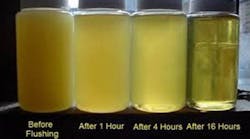Water removal filters are one way of removing water from hydraulic oil. Generally speaking, these filters are best suited to removing small amounts of water. If the oil is contaminated with a large amount of water, centrifuging or evaporation techniques such as vacuum dehydration and head-space flush should be considered.
There are two types of water removal filters: coalescing and polymeric. Coalescing filters work by passing the oil through a dense, inorganic fiber mat. The fibers break the oil film, which allows non-emulsified (free) water to adhere to and be retained by the fibers, while the oil passes through. As water droplets accumulate in the filter mat, they coalesce into larger droplets which drain down through the fibers into a collector, which is periodically drained.
Polymeric filters are impregnated with chemicals (polymers) that have a strong affinity for water. They can be absorptive, where free and emulsified water in the oil becomes part of the filter's chemical structure, or adsorptive, where the water is retained by the element without it becoming part of its chemical structure. Absorptive filters are preferred because they retain the water permanently. Whereas adsorptive filters have a tendency to release or 'unload' captured water under certain conditions. Polymeric filters are available in similar configurations as particulate filters.
Note that neither coalescing nor polymeric filters remove dissolved water; that is, water dissolved in the oil's molecular structure, below the saturation point. And remember, allowing the hydraulic oil to get and stay 'wet' can be a very costly mistake. And to discover six other costly mistakes you want to be sure to avoid with your hydraulic equipment, get "Six Costly Mistakes Most Hydraulics Users Make... And How You Can Avoid Them!" available for FREE download here.

Continue Reading
Continue Reading
A Word About Specific Heat Of Hydraulic Oil
March 14, 2017
Sponsored Recommendations
Sponsored Recommendations
All-In-One DC-UPS Power Solutions
March 13, 2024
Motor Disconnect Switches
March 13, 2024
Industrial Straight-Through Cable Gland
March 13, 2024
